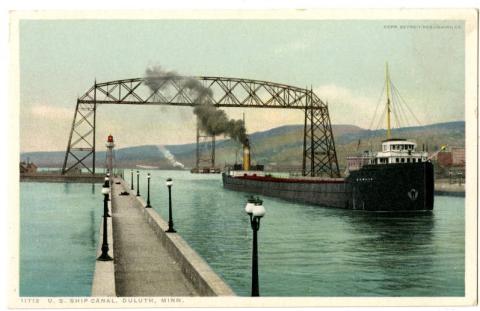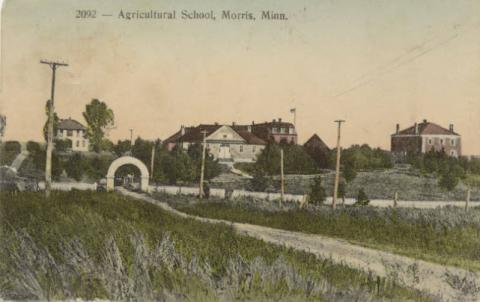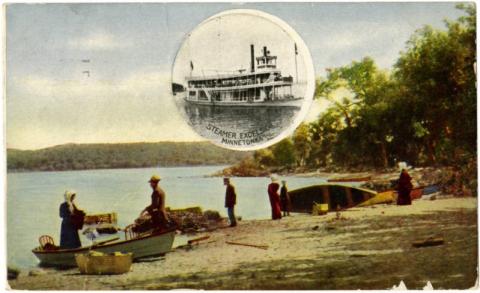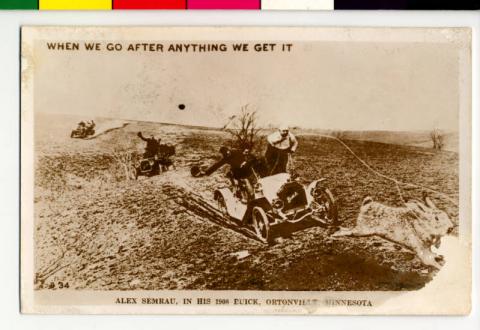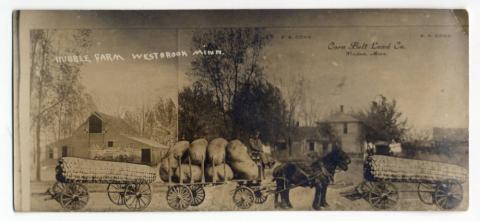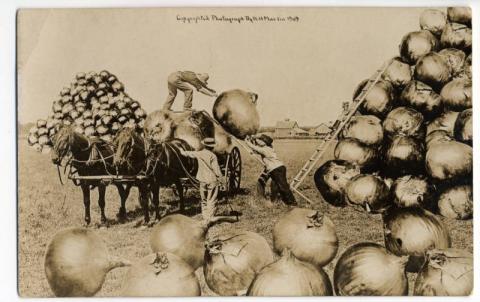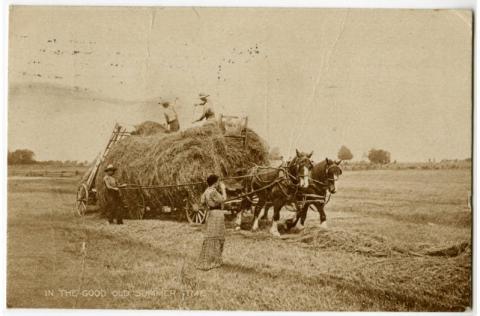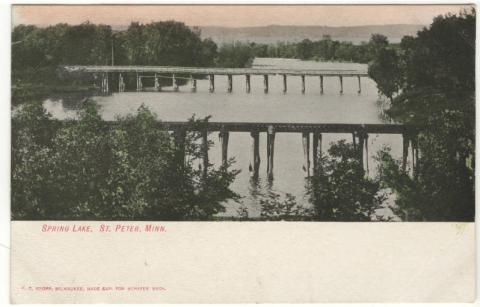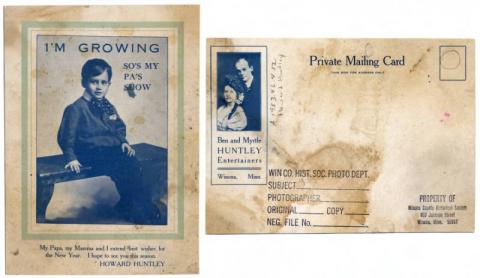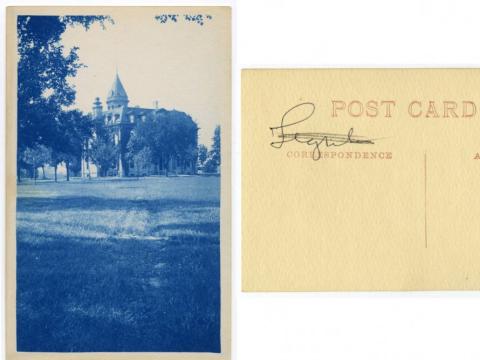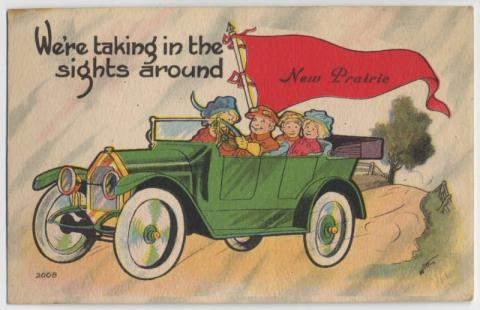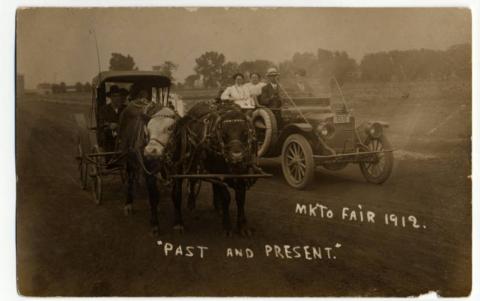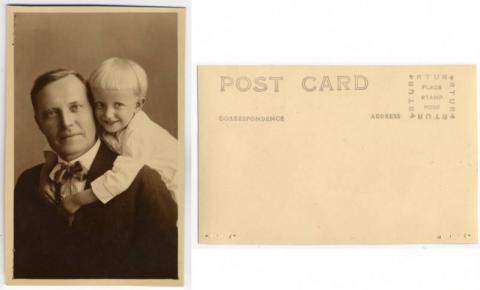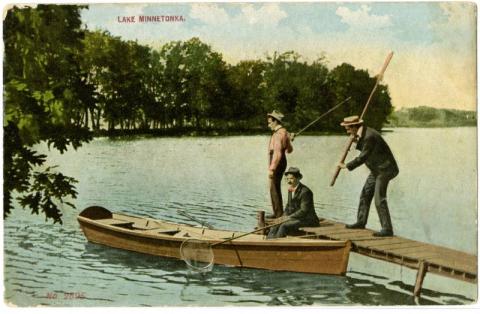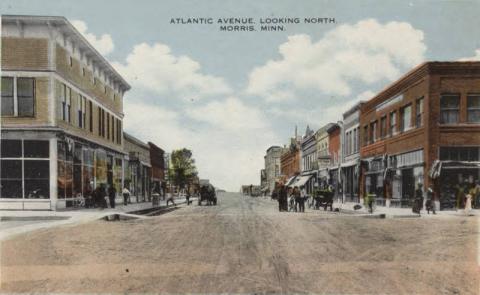Primary Source Set
by Greta Bahnemann, Metadata Librarian, Minnesota Digital Library, Minitex
Arts and Literature Communication Format Highlight
Almost everyone knows what a postcard is – having either mailed or received one. Postcards, by their formal definition, are rectangular pieces of cardstock with an image printed on the front and a space for a message and an address on the reverse. Postcards are an early form of quick and easy communication - some might even say they were the printed predecessor of an e-mail. They are often mailed from vacation spots, from business travel, or just as an easy way to send a greeting. The postcard's "Golden Age" was the turn of the last century.
During the early years of the 20th century, the buying, sending and collecting of postcards was an international phenomenon. Postcards depicting "holiday and vacation spots" were produced alongside cards to celebrate Christmas and birthdays. Common subject matter also included architectural landmarks and small town Main Streets, famous actors and beautiful women, ships, trains and locomotives, animals, military leaders, and European royalty. As postcards gained in popularity, Kodak introduced two new options for postcard creation: a specially designed folding pocket camera that used postcard-size film and preprinted stock paper that allowed customers to make a postcard from any photograph they took. Many small town photography studios also created these "real photo" postcards.
As postcards became increasingly common, they helped to document changing societal norms such as the rise of the automobile and American car culture or the fight for women's suffrage, and America's evolving attitudes towards race and class. Postcards also helped chronicle changes in clothing and dress. Not all postcards were serious in nature. A large number of postcards featured cartoon characters, jokes, and a new phenomenon called "tall tale postcards." Tall tale cards featured photographic exaggerations of oversize produce and animals. An example of this type of card might feature two enormous strawberries loaded onto a railroad car or several ears of corn loaded into a wagon. These images humorously helped to promote the idea that America was a place of agricultural bounty and plenty. In sum, the humble postcard has documented and chronicled some of the changes in American society.
Phases of Postcard Production in the United States:
- 1898-1901 Private Mailing Cards: The United State Postal Service first introduced Postcards to the American public in 1898.
- 1901-1907 Early Postcard Period: During this period postcard senders wrote their message on a small white space on the front of the card. The recipient's address on the back was the only thing included on the postcard back.
- 1907-1914 Divided Back Postcards: In 1907 the U.S. Postal Service declared that all postcards printed in the United States should have a divided back. A vertical line divided the postcard back and senders wrote their message on the left side and the address on the right side of the line.
- 1915-1930 White Border Period: During World War I, printers began adding a white border to postcards to save on the cost of ink. This practice continued beyond World War I and extended into the 1930s.
- 1930-1944 Linen Period: Beginning in 1930, postcard paper was made from a higher cotton rag content. This allowed the paper to be printed to resemble the texture of canvas or linen. Bright colors were frequently used in conjunction with a white border.
- 1939-present Modern Postcard Period: Postcard images are usually based on color photographs. These postcards can be easily identified by the paper’s glossy coating.
Discussion Questions & Activities
- Look at the tall-tale postcards (postcard #4, postcard #5, and postcard #6). At the time these postcards were created, many Americans lived on a farm. What do these cards tell us about American society at the time? How do these postcards use humor to talk about things like "manifest destiny" and the American dream?
- Review the date ranges of postcards as outlined in the introduction paragraph. Based on that information, what date would you assign to postcard #8, postcard #13, and postcard #14?
- During the late 19th and early 20th centuries, most postcards were printed in Germany. After the United States entered World War I, postcards began to be printed in America. Discuss some of the factors that contributed to this trend, such as the rationing of paper and ink, anti-German feelings, and the rise of American nationalism and patriotism, etc.
- Look at postcard #3 which features both an image of a beach and an inset photograph of a boat posted onto the larger postcard. Think about how much more work it would be to produce an image like this one. Why would that be available for sale? Do you think that postcard would have cost more when it was new?
- Ask students to discuss the relative permanence of a postcard vs. the more ephemeral nature of texts, tweets, Instagram, etc. What are the advantages and disadvantages of each form of communication?
- Ask students to design their own postcards. Students should think about their intended audience and how postcards can be used to document different aspects of their community. What images would be on the front of the card? Would the postcards be mailed or delivered electronically? What stories could you tell with postcards that perhaps you couldn't tell with a text message or an e-mail?
- Ask students to design their own version of a tall-tale postcard. Look at the examples featured in MDL and view the the tall-tale postcard site at the Wisconsin Historical Society. What aspect of contemporary life could you exaggerate? What points could you make - either serious or humorous? How can you use humor to make a point, tell a story, or direct your audience to think about an issue?
eLibrary Minnesota Resources (for Minnesota residents)
"History of photography." Britannica Academic, Encyclopædia Britannica, 23 Jan. 2019. Accessed 11 Jul. 2019.
"Postcard." Britannica School, Encyclopædia Britannica, 26 Jun. 2018. Accessed 9 Oct. 2025.
"Postal system." Britannica Academic, Encyclopædia Britannica, 16 Feb. 2017. Accessed 11 Jul. 2019.
"Postcards." St. James Encyclopedia of Popular Culture Online, Gale, 2013. Student Resources In Context. Accessed 9 Oct. 2025.
Additional Resources for Research
Clay, Christopher S. Minneapolis and St. Paul in Vintage Postcards. Chicago, IL: Arcadia, 2002. Print.
"Postcard History." Smithsonian Institution Archives. Smithsonian Institution Archives, n.d. Web. 20 Feb. 2017.
"Postcard Galleries." Smithsonian Institution Archives. N.p., 19 Sept. 2013. Web. 20 Feb. 2017.
"Real Photo Postcard." Wikipedia. n.d. Web. 20 Feb. 2017.
Staff, Frank. The Picture Postcard & Its Origins. London: Lutterworth, 1979. Print.
Willoughby, Martin. A History of Postcards: A Pictorial Record from the Turn of the Century to the Present Day. London: Bracken, 1994. Print.
Wilson, Bonnie. Minnesota in the Mail: A Postcard History. MHS Press, 2004.
Wisconsin Historical Society. Larger Than Life: Tall-Tale Postcards | Wisconsin Historical Society. Wisconsin Historical Society, n.d. Web. 20 Feb. 2017.
Published onLast Updated on
